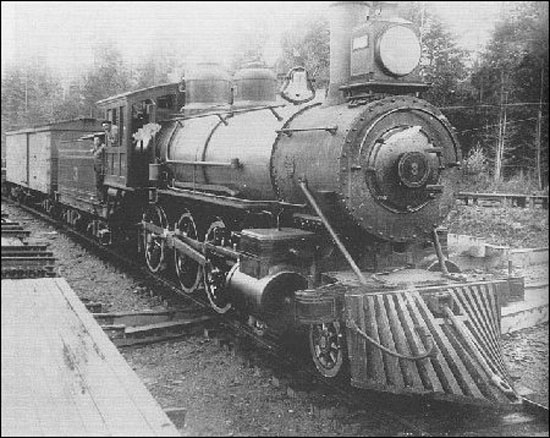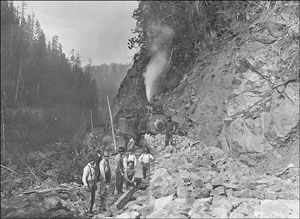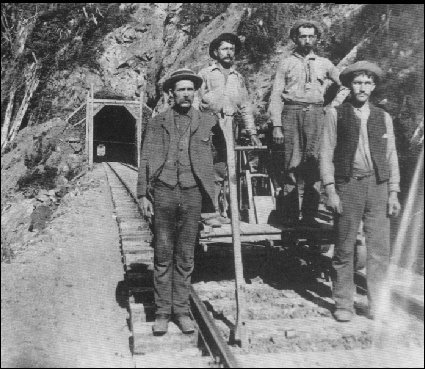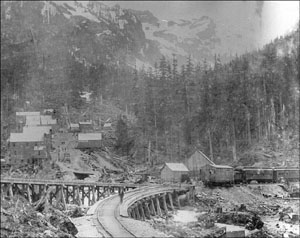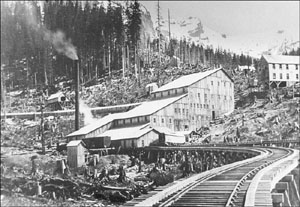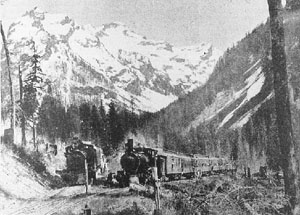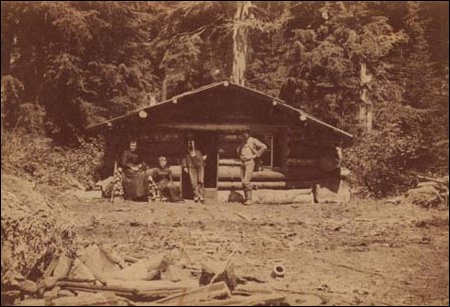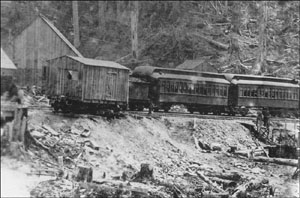 | Click on photo for full version
|
From page 36, "A small portion of an 1894 photo of Monte Cristo. The original negative is 18 inches high by 36 inches wide. Locomotive 3 of the Everett and Monte Cristo Railway hides behind a "crummy" [logging and rail crews transportation car] while waiting to pull the daily passenger train to Everett. The building behind the crummy is the railway station, which was originally a sawmill erected by the mining companies to supply timer to their mines." Photo by Frank LaRoche.
Phil Woodhouse — The picture was discovered by a real estate agent who was doing a final clearing of objects from downtown Seattle buildings before they were demolished to make was for the I-5 freeway. This fellow, whose name I do not remember, was a member of the Granite Falls Historical Society, so happened to know the subject matter, and rescued the framed picture from oblivion. Walt Meglasson, a good friend of mine, was the Society president at the time, and was able to borrow the picture so we could do some detailed photographic copies of specific areas. This was long before electronic files, scans, etc. Therefore there is no scan of the entire picture. Even today it would take an engineering scanner to scan the entire surface of the 18x36-inch print. The prints that you see on pages 36 and 42 are two of these detailed photos. The print is an albumen print on artist's canvas, and is a contact print. It was taken by Frank LaRoche in 1894, and printed in Seattle by a man named Plummer. This was likely taken with a Cirkut camera, a type of camera that was just being introduced at the time. The film was in a vertical roll, the shutter a vertical slit, and the camera rotated about a vertical axis as the film was transported past the slit at the focal plane. Thus pictures up to 360 degrees and more could be made. Cirkut cameras are still around and still being used, and yes, one was made that took 18-inch tall film. The left-hand side of this photo was badly damaged, because it was found hanging in a kitchen over a stove. Therefore the right-hand side is the only part with any detail. [See this website for a further explanation of the Cirkut camera:].
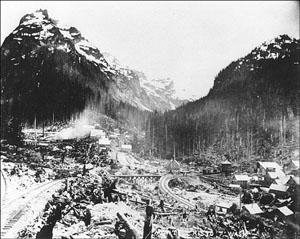 | Click on photo for full version
|
Journal comment: Frank LaRoche (1853-1936) first gained fame in Seattle, arriving there from his native Pennsylvania right after the great Seattle fire in June 1889 while the ashes were still warm. He was already trained in the field and set up shop in the Kilgen block on 2nd Avenue. His studio, in addition to high-class portrait photography, specialized in scenic and industrial views of western Washington state. After photographing the Seattle waterfront, streets and buildings, and the homes of early Everett land speculation, he moved to ships, logging camps and the series that first brought him fame, of the American Indians. He ranged as far as California and most of the Western states and as far north as the Canadian Pacific Railway. During the Klondike gold rush from 1897-1899, he trouped along with miners in southeastern Alaska and the Yukon Territory photographing and took spectacular shots at the Chilkoot Pass. Back in 1892 he photographed Indians near Sedro-Woolley and he decided to move there permanently in about 1910. He retired in 1928 after setting up shop in Maurice Schneider's block where the former bowling alley stands today on Metcalf. He died in Sedro-Woolley on April 12, 1936. His son, with the same name, trained at his father's shop and then moved the business to Bremerton where he died in 1948.
|

 810 Central Ave., Sedro-Woolley, Washington, 98284
810 Central Ave., Sedro-Woolley, Washington, 98284